In November, 2010, I saw Bastard, the first part of Pavel Zustiak’s extraordinary trilogy, The Painted Bird, inspired by Jerzy Kozinski’s novel of that name. In June, 2011, I saw the second installment, Amidst. From May 3 through 13, 2012, Zustiak’s group, Palissimo, is performing the final work, Strange Cargo. The novel’s passage over time and distances, as well as its themes of displacement, concealment, identity and transformation are embedded in all three structures and what they ask of spectators.
Bastard premiered in LaMama’s conventional black-box theater, with spectators tiered at one end. Amidst was an installation-performance at the Baryshnikov Arts Center; watchers wandered around and between the dancers in a large space devoid of seating. Under the soaring roof of the vast Synod House at St. John the Divine, the audience for Strange Cargo (a co-presentation with P.S. 122) is divided into two long rows of chairs on either side of an open area. Those of us fortunate enough to have experienced Zustiak’s complete The Painted Bird have, in a sense, been traveling for two and a half years to get from East 4th Street to West 110th Street. (My journey has its own aspects of exile and homecoming; for complex reasons, I was unable to write about Bastard and when I saw Amidst, I was in professional limbo, with no place to publish my impressions.)
Bastard, a solo for the brilliant Slovak actor-dancer Jaro Vinarsky, drew metaphorically on a scene from Kozinski’s book that described a perhaps fictional Polish village custom: a snared bird is painted in bright colors and released amid its flock; the other birds tear it to pieces; the townspeople laugh. In the unforgettable first minutes of Bastard, a red-coated creature perhaps four feet tall, began to travel away from us, as if on ball-bearings. It took me a while to realize that this was Vinarsky, masked and walking in a squat. He traced the entire periphery of the space doing this. Eventually he began to show signs of stress, rocking a bit, straining forward slightly. He fell, rose again, moved on, fell, lay with his coat over his head, twitching.
Throughout Bastard, Vinarsky—stripped to black trunks—played the fugitive with terrifying force—wedging himself into niches in the set, attempting to climb the staircases at the back of the theater. He rubbed black stuff on his face, hair, arms, and pants, and launched himself into staggering flight. Finally, a horde appeared and menaced him (a shock to the audience since no other performers were mentioned in the program), but Vinarsky found a way to blend in with their docile patterned moves (as I recall, these involved lying down and standing up). In the end, though, he was alone.
In Amidst, Zustiak transformed and further abstracted the traces of Kozinsky’s bildungsroman about a Jewish child on the run during World War II. At BAC’s Howard Gilman Performance Space, we piled our bags as instructed and stood in a dimly-lit, fog-filled limbo. Slides began to appear on the walls, mostly photos of faces—haunted, stoic, undecipherable. One or more of the performers (Lindsey Dietz Marchant, Nicholas Bruder, and Zustiak) would appear in our midst, even touch us as they pushed through. Or Joe Levasseur’s lighting would pick out an area where something was happening, and we’d close in. But often there was more than one “performance” moment happening before the dancer(s) rushed away and disappeared into a cluster of people.
Only twice (I think) did the three performers come together—once to tangle and once for Bruder and Dietz Marchant to collaborate on dressing the immobile Zustiak in one outfit after another—stripping clothes off him and slapping new disguises on at an increasingly desperate pace.
Unthreatened though we were, a sense of displacement and discomfort was unavoidable. Where were we to go? Was that projected pattern a road map? We were the “flock,” united in our purpose, but also designated as outsiders by virtue of being spectators. At some point, a light shone on our heaped-up bags and coats. We’d left our baggage in order to enter this zone and would have to paw through the heap to reclaim it. In Kozinski’s world, we might have walked away with someone else’s load—to a crueler place than West 37th Street.
Christian Frederickson composed the terrific music that’s intimately connected to all three parts of Zustiak’s work and played it live during the performances. For Bastard and Amidst, he was joined by Jason Noble and Ryan Rumery. For Strange Cargo, Frederickson plays guitar and viola, and Rumery (credited as a co-composer) mans the drum set and other percussion instruments; the score also includes atmospheric recorded elements, including the occasional taped voice. Levasseur again creates imaginative lighting.
This time, there are five performers. Giulia Carotenuto, Luke Murphy, Denisa Musilova, and Jeremy Xido join Dietz Marchant. Zustiak has said that in this final part of The Painted Bird, he is exploring the connotations of home—perhaps a refuge, perhaps a place in which we confront ourselves, or our various notions of self (and not always peacefully). The violence that is contained in Bastard and barely hinted at in Amidst often erupts here. When Xido confronts Murphy aggressively across a table, and Murphy, seated on a chair, recoils, you can imagine an interrogation, but also a confrontation between a man and his image of himself.
The performers enter on all fours. Xido, the first to arrive moves like an animal tracking a scent, occasionally pausing before placing a hand on the floor to continue his path. But the crawling turns faster and the tracks more wayward; people collide, knock one another over. Then they retreat into eccentric behavior. Dietz Marchant puts her shoes on her hands, Xido turns his finger into a gun, and Musilova contemplates herself in the virtual mirror of her palm.
Clothing as a statement of identity figures in Strange Cargo, as it did in its predecessors. The performers often remove outer garments and put different ones on. At one point, Carotenuto and Musilova re-enter the arena wearing head-covering outfits that suggest those of Muslim women; somewhat later, the men uncover them. In one solo, Dietz Marchant, an unchangingly bright smile glued on her face, struts around to the sounds of a recorded march wearing cowboy boots. The performers also move four lamps on stands. In one alarming sequence, they bear a light with them as they travel slowly along as a unit, staying linked to one another in tableaux both cruel and tender. It’s as if you’re watching a slideshow of a family fight. The five voyage through actual space encased in turmoil.
Competition is never entirely absent. Xido joins Dietz Marchant in her power display, but finds his own pattern. Suddenly he pins her down and drags her along. Murphy vaults onto the table; his act inspires others to get a turn on it, which usually means pushing someone else off. In a seemingly lighter moment, they race around and tumble—dodging one another playfully. At first.
Zustiak creates no movement that looks like dancing for its own sake. It becomes a statement of identity, a task to be completed, an urge to be satisfied. The superbly expressive performers run themselves ragged, pummeling the air with their bodies, never fully at rest. A narrow banner of mylar, strung high between two poles at the opposite end of the area from the musicians, throws back distorted reflections, further confounding issues of selfhood and stability. The performers hurl imaginary rocks at it; they also stand in front of it, arms raised, as if stymied by an impassable frontier.
Since each half of the audience sees the actions of the dancers against the background of the other half, we’re reminded of the fragility of refuges; in many villages, cities, countries, someone is almost always watching. For a few seconds, Levasseur turns the lights on “them,” then on “us,” or vice versa. In Zustiak’s enigmatic ending, nothing remains on stage but the table, inverted, its legs in the air.
Last year, it was planned to show all three parts of The Painted Bird this May. For various reasons, that project had to be postponed. I hope it comes to pass. Trekking through the city to different venues in the course of a single day or two to take in the entire work would be a soul-stirring journey.

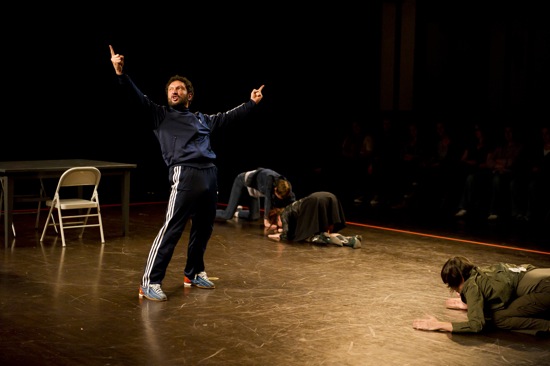
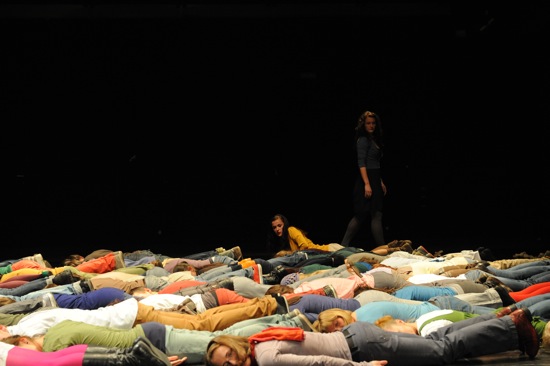
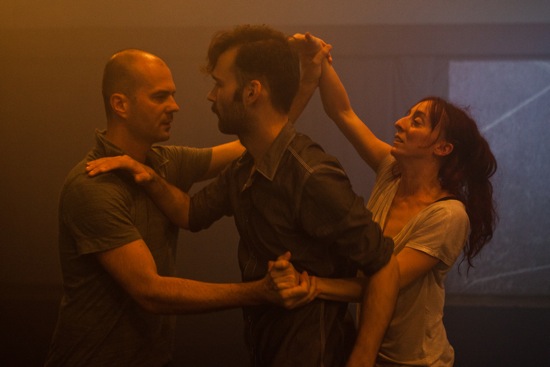
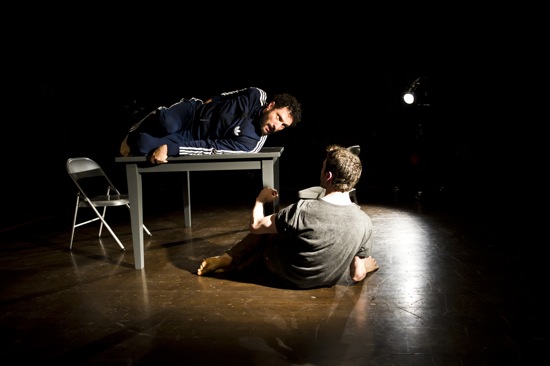
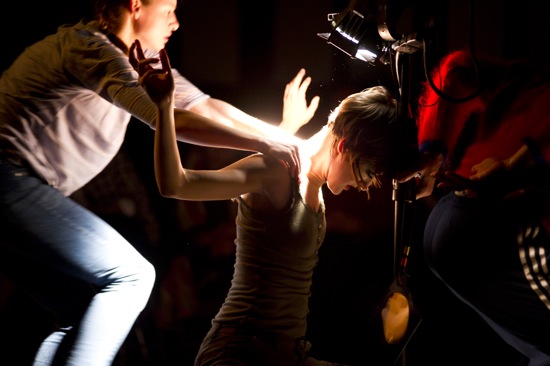
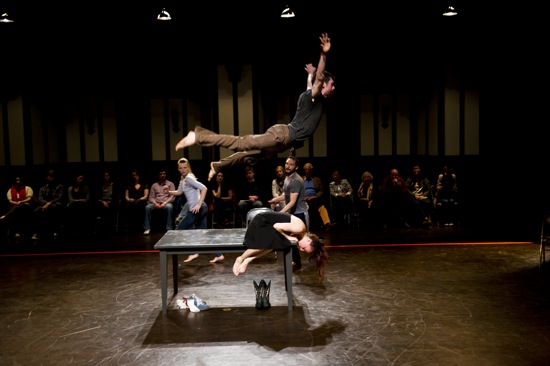
This is what makes you wonderful Deborah! The commitment to the artists that you have and that you truly follow their works and their progress is extraordinary! Thank you for being so dedicated.